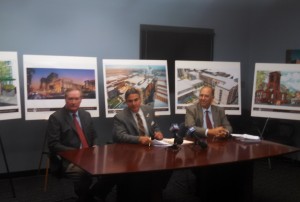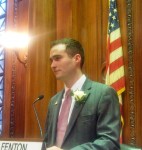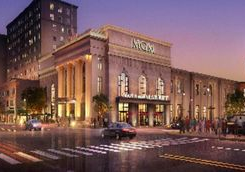Unexpectedly, MGM Springfield Won’t Tower over Anything…
UPDATED 10/1/15 2:07AM: To reflect a correction. A previous version of this post credited MGM’s new rendering to us, when in fact it is MGM’s image obtained via the Springfield city website.

From left, CDO Kevin Kennedy, Mayor Domenic Sarno & City Solicitor Ed Pikula at Tuesday’s press event (WMassP&I)
SPRINGFIELD—The skyline will not undergo any dramatic changes when MGM Springfield opens after design changes removed the gleaming 25-story hotel tower featured as part of the project since its earliest days. The Las Vegas-based company announced today it was scaling back the height, but not the size of the hotel included in its $800 million gaming complex.
MGM made no public appearances to announce the change, but Mayor Domenic Sarno, flanked by Chief Development Officer Kevin Kennedy and City Solicitor Ed Pikula, did hold a media availability at the city’s Tapley Street building. Despite putting forth their best spin, the loss of the casino’s visual anchor was greeted with skepticism from reporters and city councilors.
Describing himself as “skeptical” when MGM first broached the change 10 days ago, Sarno nevertheless insisted, “We think it is a positive change.” He, Kennedy and Pikula all argued that a smaller structure was more conducive to walkability and to a New England setting versus a Las Vegas one, echoing MGM’s architectural rationale for the new layout. They were adamant that MGM was not scaling back its plans.
Yea, about that 25-floor hotel @MGMSpringfield was going to have… http://t.co/qoRtfLZAUA pic.twitter.com/lhFydFslAk
— John Beattie (@JohnBeattie_) September 22, 2015
The mayor noted MGM’s conversations with historic commissions as an impetus for the redesign, although MGM’s release emphasized opening up the development to Main Street.
As the shorter hotel on Main Street will move the project’s 54 market-rate housing units off-site, Sarno called it an opportunity to “spread the wealth around downtown.” Untethered from the casino timeline, those units could open sooner, although where is not yet known. Kennedy said MGM was in talks with nearby property owners, possibly Peter Picknelly’s OPAL Real Estate Group.
Pikula said revisions to the host community agreement between the city and Blue Tarp, LLC—the legal name of MGM Springfield’s developer—would need to be ratified by the City Council and the Gaming Commission. Early reaction from councilors was decidedly wary.
At-large councilor Kateri Walsh was “surprised” and “disappointed,” because it differed from what voters approved in 2013. “I wonder how people are going to feel about the change in the plan,” adding she had to give it “a lot of thought” before deciding whether to approve the changes.
Walsh also observed MGM’s absence from the availability.
City Council President Michael Fenton, rarely at a loss for words, was flabbergasted. “I don’t know what to say. I’m speechless.” He lamented losing the addition to Springfield’s skyline, “That was the ‘wow’ factor.” He, too, need time to decide how he would vote.
Kennedy downplayed MGM’s absence. Speaking to reporters, he said, “They can do what they want from a press perspective.” Both he and Sarno noted that they, too, had “due diligence” to perform, but remained sanguine about the new design.
As of posting time, an MGM representative had not returned requests for comment.
Pikula also said the changes would go before the Massachusetts Gaming Commission. Elaine Driscoll, a spokesperson for the commission, deferred comment about changes until Thursday’s gaming commission meeting in Springfield.
Sarno did not bite when asked if Connecticut’s gaming expansion precipitated these changes, “We worry about our side of the state here.”
Led by the Pequot and Mohegan tribes, Connecticut’s move could threaten MGM Springfield’s plan to attract customers from Metro Hartford. MGM had derided the tribes’ effort to dam up their customer base, until it sued Connecticut, arguing the state unconstitutionally prohibited MGM from also seeking a casino license there.
Officials insisted that this would not reduce the $800 million project cost. The total might even rise, but officials were vague as to how. “We weren’t so much interested in the price tag,” Pikula said, than whether MGM fulfilled its commitments.
At the same time, Kennedy suggested higher constructed expenses would boost the price. Still, not building the tower would save six figures at least. Presumably that must go back into the project to maintain and/or boost the $800 million figure. Where was not clear.
Kennedy said the former location for the hotel, currently 73 State Street, would instead house a food court. Pointing to the new drawings, he said a Starbucks would go in next door. Starbucks did not return an email requesting comment.
These renderings seemingly show 73 State Street, the 1911 beaux arts United Electric Building, retained entirely, although MGM’s release only mentions the facade. Still axing the hotel is a dramatic shift from previous iterations.
MGM had agreed, in a memorandum of agreement with the state gaming and historic commission, to preserve the façade and possibly the rotunda, but nothing more. State and local historical officials seemed caught by surprise about the developments.
Ralph Slate, Chairman of the Springfield Historical Commission only learned about the changes early Tuesday morning. He said MGM had claimed 73 State Street had been the only place they could place the hotel.
“That was the reason that they couldn’t mitigate the adverse impact,” on the building he said.

73 State Street today (via centuryinvestment.com)
Brian McNiff, a spokesperson for the Massachusetts Historical Commission, said the commission only knew design changes were coming, but had no reason to think 73 State Street or other properties’ fate had changed. He declined further comment until the gaming commission received the changes.
Kennedy said he was unsure of 73 State Street’s fate or other aspect of the project’s historic perseveration, adding that was part of the due diligence the city would perform.
There are also questions about what will happen to the Union House on Main Street, upon which the renderings now place the hotel. Although historic preservation officials had conceded its interior, MGM agreed to save the façade.
“Some of the reasons for demolition of 73 State Street have now disappeared,” Robert McCarroll emailed, speaking as the Springfield Preservation Trust’s representative on Springfield’s historical commission. “It is unknown how the Main Street hotel will impact Union House.”
Referring to the state historical commission, he added, “The question is whether MHC will want to reopen the consultation process.” McCarroll said.


